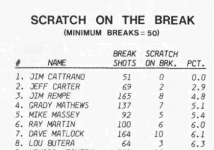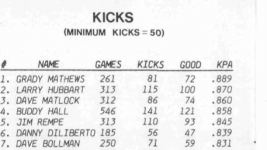James Dean_Yo
Registered
Why do I push in the game of 9ball, when I could have kicked with firm speed and still monkeyed the rack to the point of no run out anyways?
What are the tentative odds of winning the rack when you push and let the opponent to the table compared to just letting the cue ball fly into the OB and either A.) FOUL B.) HIT THE OB AND SLOP A BALL IN, ETC OR C.) PULL A MAGICIAN KICK SAFE ? ? ?
I guess my thought is unorganized so my question is: Is there a way of looking at the push maneuver in the game of 9ball from a statistical standpoint? If so, would someone want to try and run the odds on how each particular scenario could play out?
If this can be answered from a numbers standpoint, I would be interested if it would change one's decision to push out. I do fully understand the purpose of inducing your opponent into a shot that can be beneficial to you (the initial shooter). I also understand that there are situations where you have to push because it's the only way to legally move the CB w/o fouling but, what about those other situations!?
All schools of thought are welcome, JD_YO
What are the tentative odds of winning the rack when you push and let the opponent to the table compared to just letting the cue ball fly into the OB and either A.) FOUL B.) HIT THE OB AND SLOP A BALL IN, ETC OR C.) PULL A MAGICIAN KICK SAFE ? ? ?
I guess my thought is unorganized so my question is: Is there a way of looking at the push maneuver in the game of 9ball from a statistical standpoint? If so, would someone want to try and run the odds on how each particular scenario could play out?
If this can be answered from a numbers standpoint, I would be interested if it would change one's decision to push out. I do fully understand the purpose of inducing your opponent into a shot that can be beneficial to you (the initial shooter). I also understand that there are situations where you have to push because it's the only way to legally move the CB w/o fouling but, what about those other situations!?
All schools of thought are welcome, JD_YO
Last edited:



